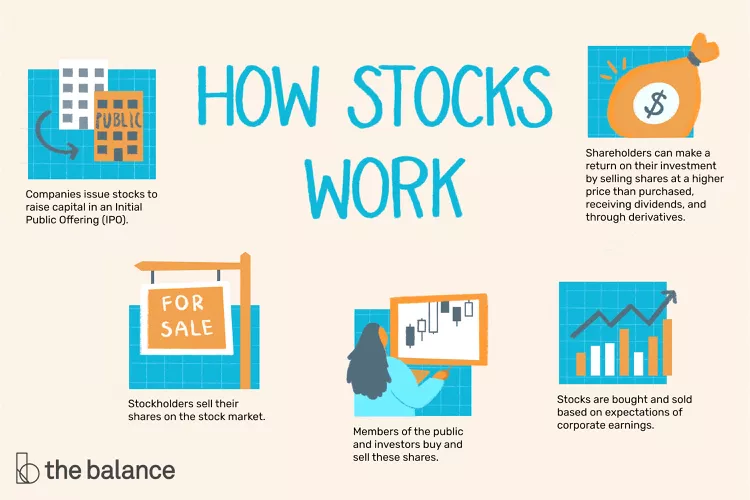What Are Stocks?

Definition and Example of Stocks
Stocks represent ownership in a publicly traded company. When you buy a company’s stock, you become part-owner of that company. For example, if a company has 100,000 shares, and you buy 1,000 of them, you own 1% of the company. Owning stocks allows you to earn more from the company’s growth and gives you shareholder voting rights. Alternative names include shares and equity.
How Stocks Work
Companies sell stocks to gain additional funds to grow their business, launch new products, or pay off debt. The first time a company issues stocks to the public is called the “initial public offering” (IPO). After the IPO, stockholders can resell their shares on the stock market—where prices are driven by supply and demand.
Investor.gov. “Initial Public Offering (IPO).”
The more stock offered for sale, the lower the price will drop. The more people buying a stock, the higher the price will rise. Generally, people buy or sell stocks based on expectations of corporate earnings or profits. If traders think a company’s earnings are high or will rise further, they bid up the price of the stock.
One way in which shareholders make a return on their investment is by selling shares at a higher price than where they were purchased. If a company doesn’t do well, and its shares decrease in value, you could lose part—or even all—your investment when you sell.
The other way shareholders profit is through dividends. These are quarterly payments distributed on a per-share basis out of a company’s earnings. It is a way to reward and to share earnings with stockholders—the actual owners of the company—for investing. Dividends are especially important for companies that are profitable but do not grow exponentially due to either:
- Being in a mature or stable phase in the company’s lifecycle
- The type of industry they operate in (for instance, utilities versus technology)
Popular dividend-paying stocks are often known as value or blue-chip stocks.
The third, riskier way to profit from stocks is from derivatives, which derive their value from underlying assets, such as stocks and bonds. Stock options give you the option to buy or sell a stock at a certain price by an agreed-upon date.
A call option is the right to buy at a set price. When the stock price goes up, you make money by purchasing it at the fixed lower price and selling it at today’s price. A put option is the right to sell at a set price. You make money when the stock price declines. In that case, you buy it at tomorrow’s lower price and sell it at the agreed-upon higher price.
Primary Types of Stocks
Common Stocks
Common stocks are tracked on the Dow Jones Industrial Averages and the S&P 500. Their values depend on when they are traded. Common stock owners can vote on a corporation’s affairs, such as the board of directors, mergers and acquisitions, and takeovers.
However, if a company goes bankrupt and liquidates its assets, common stock owners are last in line for a payout, behind the company’s bondholders and preferred stockholders.
Preferred Stocks
Preferred stocks also represent an ownership stake in a company, but with no voting rights. Holders know the exact amount of return to expect on dividends because their dividend payments are fixed. Preferred stocks can be converted into another form of ownership.
Other Types of Stocks
Beyond those fundamental classifications, more ways exist to categorize stocks.
Stock Industry Sectors
You can also classify stocks based on the characteristics of the companies that issued them. These different groupings meet the varying needs of shareholders. Stocks can be grouped by industry sector, including:
- Basic materials: Companies that extract natural resources
- Conglomerates: Global companies in different industries
- Consumer goods: Companies that provide goods to sell at retail to the general public
- Financial: Banks, insurance, and real estate companies
- Healthcare: Healthcare providers, health insurance, medical equipment suppliers, and drug companies
- Industrial Goods: Manufacturing companies
- Services: Companies that get products to consumers
- Technology: Computers and software
- Utilities: Electric, gas, and water companies
Growth Stocks
Stocks can also be grouped based on potential and value. Growth stocks are expected to experience rapid growth, but they usually don’t pay dividends. Sometimes, the companies may not even be making a profit yet, but investors believe the stock price will rise. These are typically younger companies that have much room for business growth and additions to their business model.
Value Stocks
A value stock is a company whose stock is trading at a lower price than its fundamentals, such as dividends or other metrics or multiples. The price of the stock itself is not expected to rise much. These tend to be large companies that aren’t new, so the market ignores them. Savvy investors see the prices as undervalued for what the companies deliver.
Blue-Chip Stocks
Blue-chip stocks are fairly valued and might not grow quickly, but they have proven to be reliable companies in stable industries over the years. They pay dividends and are considered safer investments than growth or value stocks. They are sometimes called “income stocks.”
